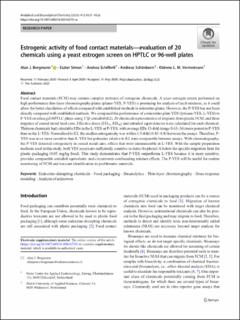Bitte benutzen Sie diese Kennung, um auf die Ressource zu verweisen:
https://doi.org/10.21256/zhaw-20105| Publikationstyp: | Beitrag in wissenschaftlicher Zeitschrift |
| Art der Begutachtung: | Peer review (Publikation) |
| Titel: | Estrogenic activity of food contact materials : evaluation of 20 chemicals using a yeast estrogen screen on HPTLC or 96-well plates |
| Autor/-in: | Bergmann, Alan J. Simon, Eszter Schifferli, Andrea Schönborn, Andreas Vermeirssen, Etiënne L. M. |
| et. al: | No |
| DOI: | 10.1007/s00216-020-02701-w 10.21256/zhaw-20105 |
| Erschienen in: | Analytical and Bioanalytical Chemistry |
| Band(Heft): | 412 |
| Heft: | 19 |
| Seite(n): | 4527 |
| Seiten bis: | 4536 |
| Erscheinungsdatum: | 27-Mai-2020 |
| Verlag / Hrsg. Institution: | Springer |
| ISSN: | 1618-2642 1618-2650 |
| Sprache: | Englisch |
| Fachgebiet (DDC): | 540: Chemie 572: Biochemie |
| Zusammenfassung: | Food contact materials (FCM) may contain complex mixtures of estrogenic chemicals. A yeast estrogen screen performed on high performance thin-layer chromatography plates (planar-YES, P-YES) is promising for analysis of such mixtures, as it could allow for better elucidation of effects compared with established methods in microtiter plates. However, the P-YES has not been directly compared with established methods. We compared the performance of a microtiter plate YES (lyticase-YES, L-YES) to P-YES on silica gel HPTLC plates using 17β-estradiol (E2), 20 chemicals representative of migrants from plastic FCM, and three migrates of coated metal food cans. Effective doses (ED10, ED50) and estradiol equivalencies were calculated for each chemical. Thirteen chemicals had calculable EDs in the L-YES or P-YES, with average EDs 13-fold (range 0.63–36) more potent in P-YES than in the L-YES. Normalized to E2, the median estrogenicity was within 1.5-fold (0.43–8.8) between the assays. Therefore, P-YES was as or more sensitive than L-YES but potencies relative to E2 were comparable between assays. With chromatography, the P-YES detected estrogenicity in coated metal cans, effects that were unmeasurable in L-YES. With the sample preparation methods used in this study, both YES assays are sufficiently sensitive to detect bisphenol A below the specific migration limit for plastic packaging (0.05 mg/kg food). This study demonstrates that P-YES outperforms L-YES because it is more sensitive, provides comparable estradiol equivalents, and circumvents confounding mixture effects. The P-YES will be useful for routine monitoring of FCM and toxicant identification in problematic materials. |
| URI: | https://digitalcollection.zhaw.ch/handle/11475/20105 |
| Volltext Version: | Publizierte Version |
| Lizenz (gemäss Verlagsvertrag): | CC BY 4.0: Namensnennung 4.0 International |
| Departement: | Life Sciences und Facility Management |
| Organisationseinheit: | Institut für Umwelt und Natürliche Ressourcen (IUNR) |
| Enthalten in den Sammlungen: | Publikationen Life Sciences und Facility Management |
Dateien zu dieser Ressource:
| Datei | Beschreibung | Größe | Format | |
|---|---|---|---|---|
| 2020_Bergmann-etal_Estrogenic-Activity-Of-Food-Contact-Materials.pdf | 812.76 kB | Adobe PDF |  Öffnen/Anzeigen |
Zur Langanzeige
Bergmann, A. J., Simon, E., Schifferli, A., Schönborn, A., & Vermeirssen, E. L. M. (2020). Estrogenic activity of food contact materials : evaluation of 20 chemicals using a yeast estrogen screen on HPTLC or 96-well plates. Analytical and Bioanalytical Chemistry, 412(19), 4527–4536. https://doi.org/10.1007/s00216-020-02701-w
Bergmann, A.J. et al. (2020) ‘Estrogenic activity of food contact materials : evaluation of 20 chemicals using a yeast estrogen screen on HPTLC or 96-well plates’, Analytical and Bioanalytical Chemistry, 412(19), pp. 4527–4536. Available at: https://doi.org/10.1007/s00216-020-02701-w.
A. J. Bergmann, E. Simon, A. Schifferli, A. Schönborn, and E. L. M. Vermeirssen, “Estrogenic activity of food contact materials : evaluation of 20 chemicals using a yeast estrogen screen on HPTLC or 96-well plates,” Analytical and Bioanalytical Chemistry, vol. 412, no. 19, pp. 4527–4536, May 2020, doi: 10.1007/s00216-020-02701-w.
BERGMANN, Alan J., Eszter SIMON, Andrea SCHIFFERLI, Andreas SCHÖNBORN und Etiënne L. M. VERMEIRSSEN, 2020. Estrogenic activity of food contact materials : evaluation of 20 chemicals using a yeast estrogen screen on HPTLC or 96-well plates. Analytical and Bioanalytical Chemistry. 27 Mai 2020. Bd. 412, Nr. 19, S. 4527–4536. DOI 10.1007/s00216-020-02701-w
Bergmann, Alan J., Eszter Simon, Andrea Schifferli, Andreas Schönborn, and Etiënne L. M. Vermeirssen. 2020. “Estrogenic Activity of Food Contact Materials : Evaluation of 20 Chemicals Using a Yeast Estrogen Screen on HPTLC or 96-Well Plates.” Analytical and Bioanalytical Chemistry 412 (19): 4527–36. https://doi.org/10.1007/s00216-020-02701-w.
Bergmann, Alan J., et al. “Estrogenic Activity of Food Contact Materials : Evaluation of 20 Chemicals Using a Yeast Estrogen Screen on HPTLC or 96-Well Plates.” Analytical and Bioanalytical Chemistry, vol. 412, no. 19, May 2020, pp. 4527–36, https://doi.org/10.1007/s00216-020-02701-w.
Alle Ressourcen in diesem Repository sind urheberrechtlich geschützt, soweit nicht anderweitig angezeigt.